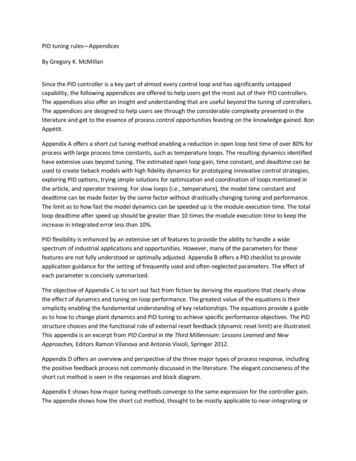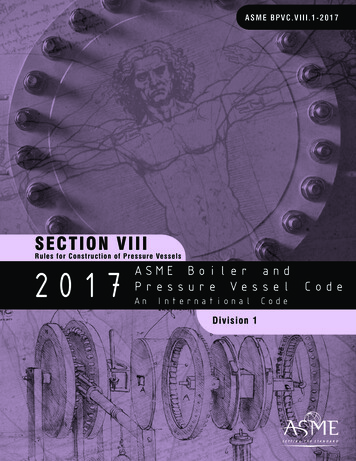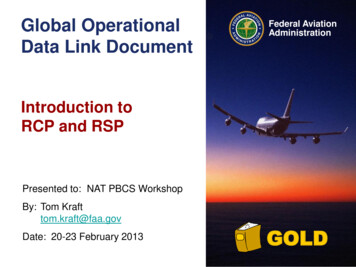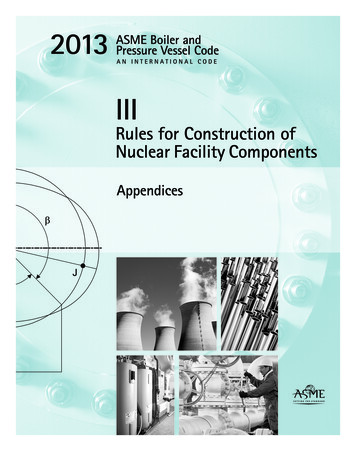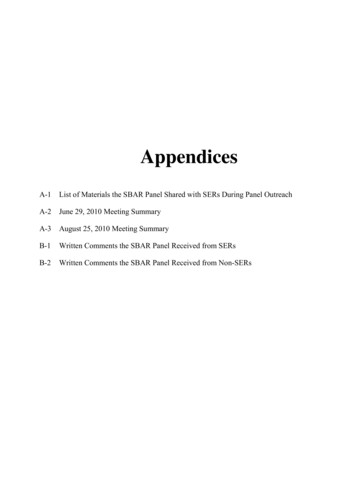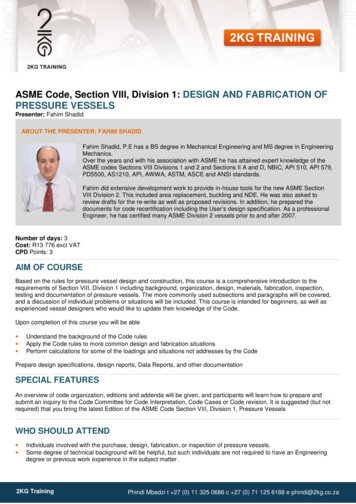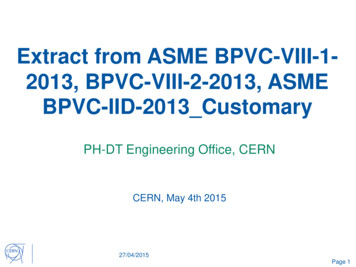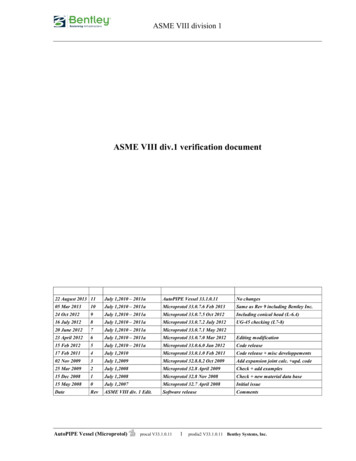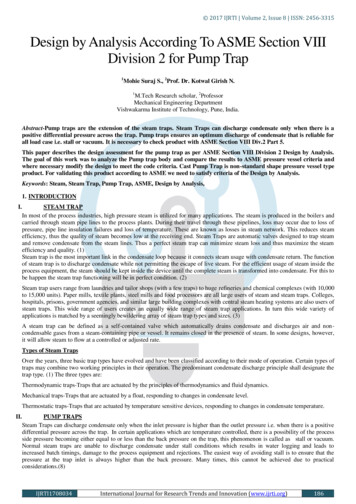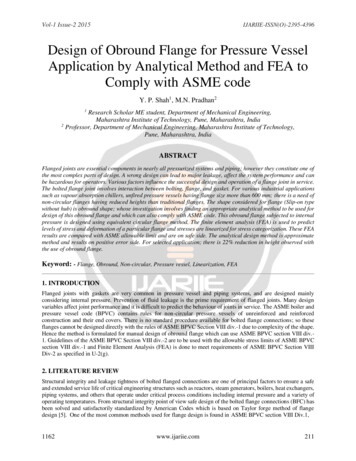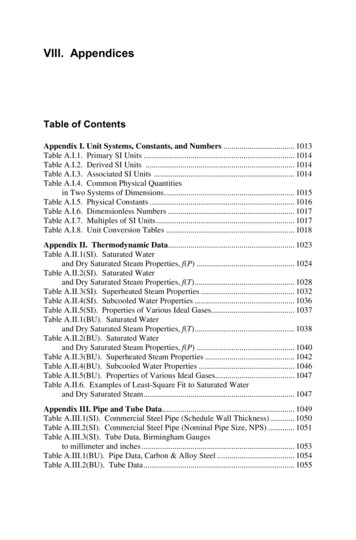
Transcription
VIII. AppendicesTable of ContentsAppendix I. Unit Systems, Constants, and Numbers . 1013Table A.I.1. Primary SI Units . 1014Table A.I.2. Derived SI Units . 1014Table A.I.3. Associated SI Units . 1014Table A.I.4. Common Physical Quantitiesin Two Systems of Dimensions. 1015Table A.I.5. Physical Constants . 1016Table A.I.6. Dimensionless Numbers . 1017Table A.I.7. Multiples of SI Units. 1017Table A.I.8. Unit Conversion Tables . 1018Appendix II. Thermodynamic Data. 1023Table A.II.1(SI). Saturated Waterand Dry Saturated Steam Properties, f(P) . 1024Table A.II.2(SI). Saturated Waterand Dry Saturated Steam Properties, f(T). 1028Table A.II.3(SI). Superheated Steam Properties . 1032Table A.II.4(SI). Subcooled Water Properties . 1036Table A.II.5(SI). Properties of Various Ideal Gases. 1037Table A.II.1(BU). Saturated Waterand Dry Saturated Steam Properties, f(T). 1038Table A.II.2(BU). Saturated Waterand Dry Saturated Steam Properties, f(P) . 1040Table A.II.3(BU). Superheated Steam Properties . 1042Table A.II.4(BU). Subcooled Water Properties . 1046Table A.II.5(BU). Properties of Various Ideal Gases. 1047Table A.II.6. Examples of Least-Square Fit to Saturated Waterand Dry Saturated Steam. 1047Appendix III. Pipe and Tube Data. 1049Table A.III.1(SI). Commercial Steel Pipe (Schedule Wall Thickness) . 1050Table A.III.2(SI). Commercial Steel Pipe (Nominal Pipe Size, NPS) . 1051Table A.III.3(SI). Tube Data, Birmingham Gaugesto millimeter and inches . 1053Table A.III.1(BU). Pipe Data, Carbon & Alloy Steel . 1054Table A.III.2(BU). Tube Data. 1055
1012VIII. AppendicesTable A.III.4. Navier-Stokes Equationsin the Cylindrical Coordinate System . 1056Table A.III.5. Navier-Stokes Equationsin the Spherical Coordinate System . 1056Table A.III.6. Substantial Derivative and Flow Acceleration Components(Cylindrical Coordinates). 1057Table A.III.7. Substantial Derivative and Flow Acceleration Components(Spherical Coordinates). 1057Appendix IV. Thermophysical Data. 1059Table A.IV.1(SI). Thermophysical Propertiesof Selected Metallic Solids. 1060Table A.IV.2(SI). Thermophysical Propertiesof Selected Nonmetallic Solids . 1064Table A.IV.3(SI). Thermophysical Propertiesof Common Materials at 300 K. 1066Table A.IV.4(SI). Thermophysical Propertiesof Gases at Atmospheric Pressure. 1072Table A.IV.5(SI). Thermophysical Propertiesof Saturated Water and Saturated Steam. 1077Table A.IV.6(SI). Thermophysical Properties of Liquid Metals. 1079Table A.IV.4(BU). Thermophysical Properties of Gasesat Atmospheric Pressure. 1080Table A.IV.5(BU). Thermophysical Properties of Saturated Water . 1082Table A.IV.6(BU). Thermophysical Properties of Saturated Steam . 1082Table A.IV.7(BU). Thermophysical Properties of Superheated Steam. 1083Table A.IV.8(BU). Thermal Properties of Solid Dielectricsat Normal Temperature . 1084Table A.IV.9(BU). Normal, Total Emissivity of Metallic Surfaces. 1086Table A.IV.10(BU). Normal, Total Emissivity of Non-Metallic Surfaces . 1088Appendix V. Nuclear Properties of Elements . 1091Table A.V.1(SI). Absorption Coefficient of Gamma Rays . 1092Table A.V.2(SI). Cross Sections for Neutron Interaction . 1093
Appendix IUnit Systems, Constants, and NumbersTable A.I.1. Primary SI Units . 1014Table A.I.2. Derived SI Units . 1014Table A.I.3. Associated SI Units . 1014Table A.I.4. Common Physical Quantitiesin Two Systems of Dimensions. 1015Table A.I.5. Physical constants . 1016Table A.I.6. Dimensionless Numbers . 1017Table A.I.7. Multiples of SI Units. 1017Table A.I.8. Unit Conversion Tables . 1018
1014VIII. AppendicesTable A.I.1. Primary SI UnitsTable A.I.2. Derived SI UnitsTable A.I.3. Associated SI Units
Appendix ITable A.I.4. Common Physical Quantities in Two Systems of Dimensions1015
1016VIII. AppendicesTable A.I.5. Physical Constants
Appendix ITable A.I.6. Dimensionless NumbersTable A.I.7. Multiples of SI Units1017
1018VIII. AppendicesThe conversion tables are arranged in the form of a square matrix. Values on thediagonal are all unity. To convert units in each row of the first column to units ineach column of the first row, multiply by the corresponding value in the matrix.Values below the diagonal are the inverse of the values above the diagonal. Unitconversion can be performed by using the software on the accompanying CDROM.Table A.I.8.1. Conversion Factors (Length)Table A.I.8.2. Conversion Factors (Area)Table A.I.8.3. Conversion Factors (Volume)Table A.I.8.4. Conversion Factors (Mass)
Appendix ITable A.I.8.5. Conversion Factors (Density)Table A.I.8.6. Conversion Factors (Time)Table A.I.8.7. Conversion Factors (Flow)Table A.I.8.8. Conversion Factors (Force)Table A.I.8.9. Conversion Factors (Pressure and Momentum Flux)1019
1020VIII. AppendicesTable A.I.8.10. Conversion Factors (Energy, Work, Enthalpy, and Torque)Table A.I.8.11. Conversion Factors (Power)Table A.I.8.12. Conversion Factors (Power Density)Table A.I.8.13. Conversion Factors (Heat Flux)Table A.I.8.14. Conversion Factors (Thermal Conductivity)
Appendix ITable A.I.8.15. Conversion Factors (Heat Transfer Coefficient)Table A.I.8.16. Conversion Factors (Viscosity)1021
Appendix IIThermodynamic DataTable A.II.1(SI). Saturated Waterand Dry Saturated Steam Properties, f(P) . 1024Table A.II.2(SI). Saturated Waterand Dry Saturated Steam Properties, f(T). 1028Table A.II.3(SI). Superheated Steam Properties . 1032Table A.II.4(SI). Subcooled Water Properties . 1036Table A.II.5(SI). Properties of Various Ideal Gases. 1037Table A.II.1(BU). Saturated Waterand Dry Saturated Steam Properties, f(T). 1038Table A.II.2(BU). Saturated Waterand Dry Saturated Steam Properties, f(P) . 1040Table A.II.3(BU). Superheated Steam Properties . 1042Table A.II.4(BU). Subcooled Water Properties . 1046Table A.II.5(BU). Properties of Various Ideal Gases. 1047Table A.II.6. Examples of Least-Square Fit to Saturated Waterand Dry Saturated Steam. 1047
1024VIII. AppendicesTable A.II.1(SI). Saturated Water and Dry Saturated Steam Properties, f(P)
Appendix II1025Table A.II.1(SI). Saturated Water and Dry Saturated Steam Properties, f(P) (continued)
1026VIII. AppendicesTable A.II.1(SI). Saturated Water and Dry Saturated Steam Properties, f(P) (continued)
Appendix II1027Table A.II.1(SI). Saturated Water and Dry Saturated Steam Properties, f(P) (continued)See the reference for the table. This material is used by permission of John Wiley & Sons, Inc.
1028VIII. AppendicesTable A.II.2(SI). Saturated Water and Dry Saturated Steam Properties, f(T)
Appendix II1029Table A.II.2(SI). Saturated Water and Dry Saturated Steam Properties, f(T) (continued)
1030VIII. AppendicesTable A.II.2(SI). Saturated Water and Dry Saturated Steam Properties, f(T) (continued)
Appendix II1031Table A.II.2(SI). Saturated Water and Dry Saturated Steam Properties, f(T) (continued)See the reference for this table. This material is used by permission of John Wiley & Sons, Inc.
1032VIII. AppendicesTable A.II.3(SI). Superheated Steam Properties
Appendix IITable A.II.3(SI). Superheated Steam Properties (continued)1033
1034VIII. AppendicesTable A.II.3(SI). Superheated Steam Properties (continued)
Appendix IITable A.II.3(SI). Superheated Steam Properties (continued)1035
1036VIII. AppendicesTable A.II.4(SI). Subcooled Water PropertiesSee the reference for this table. This material is used by permission of John Wiley & Sons, Inc.
Appendix IITable A.II.5(SI). Properties of Various Ideal GasesSee the reference for this table.1037
1038VIII. AppendicesTable A.II.1(BU). Saturated Water and Dry Saturated Steam Properties, f(P)
Appendix II1039Table A.II.1(BU). Saturated Water and Dry Saturated Steam Properties, f(P) (continued)See the reference for this table. This material is used by permission of John Wiley & Sons, Inc.
1040VIII. AppendicesTable A.II.2(BU). Saturated Water and Dry Saturated Steam Properties, f(T)
Appendix II1041Table A.II.2(BU). Saturated Water and Dry Saturated Steam Properties, f(T) (continued)See the reference for this table. This material used by permission of John Wiley & Sons, Inc.
1042VIII. AppendicesTable A.II.3(BU). Superheated Steam Properties
Appendix IITable A.II.3(BU). Superheated Steam Properties (continued)1043
1044VIII. AppendicesTable A.II.3(BU). Superheated Steam Properties (continued)
Appendix IITable A.II.3(BU). Superheated Steam Properties (continued)See the reference for this table. This material used by permission of John Wiley & Sons, Inc.1045
1046VIII. AppendicesTable A.II.4(BU). Subcooled Water PropertiesSee the reference for this table. This material used by permission of John Wiley & Sons, Inc.
Appendix IITable A.II.5(BU). Properties of Various Ideal GasesSee the reference for this table.1047
1048VIII. AppendicesTable A.II.6. Examples of least-square fit to saturated water and dry saturated steam properties
Appendix IIIPipe and Tube DataThis appendix contains pipe and tube data in SI units followed by the same data inBU. This appendix also includes the Navier-Stokes equations in the cylindricaland spherical coordinates.Table A.III.1(SI). Commercial Steel Pipe (Schedule Wall Thickness) . 1050Table A.III.2(SI). Commercial Steel Pipe (Nominal Pipe Size, NPS) . 1051Table A.III.3(SI). Tube Data, Birmingham Gaugesto millimeter and inches . 1053Table A.III.1(BU). Pipe Data, Carbon & Alloy Steel . 1054Table A.III.2(BU). Tube Data. 1055Table A.III.4. Navier-Stokes Equationsin the Cylindrical Coordinate System . 1056Table A.III.5. Navier-Stokes Equationsin the Spherical Coordinate System . 1056Table A.III.6. Substantial Derivative and Flow Acceleration Components(Cylindrical Coordinates). 1057Table A.III.7. Substantial Derivative and Flow Acceleration Components(Spherical Coordinates). 1057
1050VIII. AppendicesTable A.III.1(SI). Commercial Steel Pipe (Schedule Wall Thickness)
Appendix IIITable A.III.2(SI). Commercial Steel Pipe (Nominal Pipe Size, NPS)1051
1052VIII. AppendicesTable A.III.2(SI). Commercial Steel Pipe (Nominal Pipe Size, NPS), (continued)
Appendix IIITable A.III.3(SI). Tube data, Birmingham Gauges to millimeter and inches1053
1054VIII. AppendicesTable A.III.1(BU). Pipe Data, Carbon & Alloy Steel
Appendix IIITable A.III.2(BU). Tube Data1055
1056VIII. AppendicesTable A.III.4. Navier-Stokes Equations in the Cylindrical Coordinate SystemTable A.III.5. Navier-Stokes Equations in the Spherical Coordinate System
Appendix III1057Table A.III.6. Substantial derivative and flow acceleration components (Cylindrical coordinates)Table A.III.7. Substantial derivative and flow acceleration components (Spherical coordinates)
Appendix IVThermophysical DataTable A.IV.1(SI). Thermophysical Propertiesof Selected Metallic Solids. 1060Table A.IV.2(SI). Thermophysical Propertiesof Selected Nonmetallic Solids . 1064Table A.IV.3(SI). Thermophysical Propertiesof Common Materials at 300 K. 1066Table A.IV.4(SI). Thermophysical Propertiesof Gases at Atmospheric Pressure . 1072Table A.IV.5(SI). Thermophysical Propertiesof Saturated Water and Saturated Steam . 1077Table A.IV.6(SI). Thermophysical Properties of Liquid Metals. 1079Table A.IV.4(BU). Thermophysical Properties of Gasesat Atmospheric Pressure. 1080Table A.IV.5(BU). Thermophysical Properties of Saturated Water . 1082Table A.IV.6(BU). Thermophysical Properties of Saturated Steam . 1082Table A.IV.7(BU). Thermophysical Properties of Superheated Steam. 1083Table A.IV.8(BU). Thermal Properties of Solid Dielectricsat Normal Temperature . 1084Table A.IV.9(BU). Normal, Total Emissivity of Metallic Surfaces. 1086Table A.IV.10(BU). Normal, Total Emissivity of Non-Metallic Surfaces. 1088
Table A.IV.1(SI). Thermophysical Properties of Selected Metallic Solids1060VIII. Appendices
Table A.IV.1(SI). Thermophysical Properties of Selected Metallic Solids (continued)Appendix IV1061
Table A.IV.1(SI). Thermophysical Properties of Selected Metallic Solids (continued)1062VIII. Appendices
Table A.IV.1(SI). Thermophysical Properties of Selected Metallic Solids (continued)Appendix IV1063
Table A.IV.2(SI). Thermophysical Properties of Selected Nonmetallic Solids1064VIII. Appendices
Table A.IV.2(SI). Thermophysical Properties of Selected Nonmetallic Solids (continued)Appendix IV1065
1066VIII. AppendicesTable A.IV.3(SI). Thermophysical Properties of Common Materials at 300 K
Appendix IV1067Table A.IV.3(SI). Thermophysical Properties of Common Materials at 300 K (continued)
Table A.IV.3(SI). Thermophysical Properties of Common Materials (continued)1068VIII. Appendices
Table A.IV.3(SI). Thermophysical Properties of Common Materials (continued)Appendix IV1069
1070VIII. AppendicesTable A.IV.3(SI). Thermophysical Properties of Common Materials (continued)
Appendix IVTable A.IV.3(SI). Thermophysical Properties of Common Materials (continued)See the reference for this table.1071
1072VIII. AppendicesTable A.IV.4(SI). Thermophysical Properties of Gases at Atmospheric Pressure
Appendix IV1073Table A.IV.4(SI). Thermophysical Properties of Gases at Atmospheric Pressure (continued)
1074VIII. AppendicesTable A.IV.4(SI). Thermophysical Properties of Gases at Atmospheric Pressure (continued)
Appendix IV1075Table A.IV.4(SI). Thermophysical Properties of Gases at Atmospheric Pressure (continued)
1076VIII. AppendicesTable A.IV.4(SI). Thermophysical Properties of Gases at Atmospheric Pressure (continued)See reference for this table.
Appendix IVTable A.IV.5(SI). Physical Properties of Saturated Water and Saturated Steam1077
1078VIII. AppendicesTable A.IV.5(SI). Physical Properties of Saturated Water and Saturated Steam (continued)See reference for this table.
Appendix IVTable A.IV.6(SI). Thermophysical Properties of Liquid MetalsSee reference for this table.1079
1080VIII. AppendicesTable A.IV.4(BU). Thermophysical Properties of Gases at Atmospheric Pressure
Appendix IV1081Table A.IV.4(BU). Thermophysical Properties of Gases at Atmospheric Pressure (continued)See the reference for this table.
1082VIII. AppendicesTable A.IV.5(BU). Thermophysical Properties of Saturated WaterSee the reference for this table.Table A.IV.6(BU). Thermophysical Properties of Saturated SteamSee the reference for this table.
Appendix IV1083Table A.IV.7(BU). Thermophysical Properties of Superheated Steam at Atmospheric PressureSee the reference for this table.
1084VIII. AppendicesTable A.IV.8. Thermal Properties of Solid Dielectrics at Normal Temperature
Appendix IV1085Table A.IV.8. Thermal Properties of Solid Dielectrics at Normal Temperature (continued)1: See Table A.IV.2(SI).See the reference for this table.
1086VIII. AppendicesTable A.IV.9. Normal, Total Emissivity of Metallic Surfaces
Appendix IVTable A.IV.9. Normal, Total Emissivity of Metallic Surfaces (continued)See the reference for this table.1087
1088VIII. AppendicesTable A.IV.10. Normal, Total Emissivity of Non-Metallic Surfaces
Appendix IVTable A.IV.10. Normal, Total Emissivity of Non-Metallic Surfaces (continued)See the reference for this table.1089
Appendix VNuclear Properties of ElementsTable A.V.1(SI). Absorption Coefficient of Gamma Rays . 1092Table A.V.2(SI). Cross Sections for Neutron Interaction . 1093
1092VIII. AppendicesTable A.V.1(SI). Absorption Coefficients of Gamma Rays for Shielding Materials
Appendix V1093Table A.V.1(SI). Absorption Coefficients of Gamma Rays for Shielding Materials (continued)
1094VIII. AppendicesTable A.V.2(SI). Cross Sections for Neutron Interaction
Appendix VTable A.V.2(SI). Cross Sections for Neutron Interaction (continued)1095
ReferencesChapter IDel Frari, Bernard, “The Global Nuclear Fuel Market, World Nuclear Association Symposium, 2001.Dubrovsky, V., “Construction of Nuclear Power Plants,” Mir Publishers, Moscow, 1981.Gavrilas, Mirela, et. al., “Safety Features of Operating Light Water Reactors of WesternDesign,” CANES, Massachusetts Institute of Technology, 2000.Graham, James J., “The Uranium Market with fewer, Better & Faster Sources?,” 27th Annual Meeting and International Conference on Nuclear Energy, Goteborg, Sweden,2000.Marion Jerry B. and Marvin L. Roush, “Energy in Perspective,” 2nd Edition, AcademicPress, 1982.Marquand C. and D. Croft, “Thermofluids,” John Wiley, 1994.Mayo, Robert M., “Introduction to Nuclear Concepts for Engineers,” ANS Publications,1998.Ramsey, Charles B. and Mohammad Modarres, “Commercial Nuclear Power,” John Wiley,1998.Suryanarayana, N. V. V., “Design and Simulation of Thermal Systems,”— “US Bureau of the Census,” www.census.gov/cgi-bin/ipc/popclockw— “Alternative sources of energy,” www.altenergy.org— “Aviation Turbine Engines,” � “British Petroleum Statistical Review of World Energy 2002,” February 2003— CNN.com, October 12, 1999— “Code of Federal Regulations, 10 CFR 50-46,” nrc.gov/NRC/CFR/Part050— “Energy Efficiency and Renewable Energy,” www.eere.energy.gov— “Energy Information Administration,” www.eia.doe.gov— “Geothermal Power Plant,” Toshiba Power Systems and Services— “Hydro-electric Power,” http://acre.murdoch.edu.au/refiles— “Iter Introduction to Fusion”, itercanada.com.— “World Energy Beyond 2050,” Journal of Petroleum Technology, JPT Online Feb.2002— “Why Nuclear Power, Comparison of Various Energy Sources.” Nucleartourist.com.— “World Nuclear Association, WNA” http://www.world-nuclear.org/info/ inf75.htmChapter IIAbbott, M. M., and H. C. Van Ness, “Thermodynamics,” McGraw-Hill, 1972.
1098ReferencesAnderson, Edward E., “Thermodynamics,” PWS Publishing Company, 1994.Bond, John W. Jr., Kenneth Watson, and Jasper A. Welsh, Jr., “Atomic Theory of Gas Dynamics,” Addison-Wesley, 1965.Eastop, T. D. and A. McConkey, “Applied Thermodynamics for Engineering Technologies,” 5th Edition, Longman Scientific & Technical, John Wiley 1993.El-Wakil, M. M., “Powerplant Technology,” McGraw-Hill, 1984.Felder, Richard M. and Ronald W. Rousseau, “Elementary Principles of Chemical Engineering Processes,” 3rd Edition, John Wiley and Sons, 1999.Hatsopoulos, G. N. and J. H. Keenan, “Prinicples of General Thermodynamics” John Wiley& Sons, Inc., 1965.Holman, J. P., “Thermodynamics,” 3rd Edition, McGraw-Hill, 1980.Howell, John R. and Richard O. Buckius, “Fundamentals of Engineering Thermodynamics,” 2nd Edition, McGraw-Hill, 1992.Huang, Francis F., “Engineering Thermodynamics, Fundamentals and Applications,”Macmillan, 1976.Masi, J. F., “Trans. ASME,” 76: 1067, October 1954.McQuiston, F. C. and J. D. Parker, “Heating, Ventilating, and Air Conditioning Analysisand Design,” John Wiley, 1977.Meyer, C. A., et. al., “ASME Steam Tables,” Thermodynamics and Transport Properties ofSteam, Sixth Edition, 1993.Moran, Michael J. and Howard N. Shapiro, “Fundamentals of Engineering Thermodynamics,” Second Edition, John Wiley & Sons, Inc. 1992.Nashchokin, V., “Engineering Thermodynamics and Heat Transfer,” Mir Publishers, Moscow, 1979.Roth, Alexander, “Vacuum Technology,” 3rd Edition, Elsevier, 1990.Reynolds, William C and Henry C. Perkins, “Engineering Thermodynamics,” McGraw-Hill1977.Smith, J. S. and H.C. Van Ness, “Introduction To Chemical Engineering Thermodynamics,” Third Edition, McGraw-Hill, 1975.Sonttag, Richard E., Claus Boorgnakke, and Gordon J. an Wylen,” Fundamentals of Thermodynamics,” fifth edition, John Wiley & Sons, Inc.1998.Todreas, Neil E., and Mujid S. Kazimi, “Nuclear Systems I. Thermal Hydraulic Fundamentals,” Hemisphere Publishing Company, 1990Van Wylen, Gordon J. and Richard E. Sonntag, “Fundamentals of Classical Thermodynamics,” 3rd Edition, English/SI Version, John Wiley & Sons, Inc. 1986.Wark, Jr., Kenneth, “Thermodynamics,” 5th Edition, McGraw-Hill, Inc., 1988.Zemansky, Mark W. and Richard H. Ditton, “Heat and Thermodynamics, an IntermediateTextbook,” Sixth edition, McGraw Hill, Inc. 1981.Zemansky, Mark W., “Temperatures Very Low and Very High,” Dover Publications Inc.,1964.Chapter IIIAris, Rutherford, “Vectors, Tensors, and Basic Equations of Fluid Mechanics,” Dover Publications Inc., 1990.Baumeister T. and E. A. Avallone, “Mark’s Standard Handbook for Mechanical Engineers,8th ed. New York, McGrawHill, 1979.Bean, H. S., “Fluid Meters: Their Theory and Application,” 6th ed., American Society ofMechanical Engineers, New York, 1971.
References1099Binder, Raymond C., “Fluid Mechanics,” Fifth Edition, Prentice Hall, 1973Boussinesq, see Brodkey, R. S.Brodkey, R. S., “The Phenomena of Fluid Motion,” 3rd printing, Addison-Wesley, 1967.Burgreen, D., “Flow Coastdown in a Loop After Pumping Power Cutoff,” Nuclear Scienceand Engineering: 6, 306–312, 1959.Carnahan B., H. A. Luther and J. O. Wilkes, “Applied Numerical Methods,” Wiley, 1969Chaudhry, M. H., “Applied Hydraulic Transients,” 2nd Edition, Van Nostrand Reinhold,1987.Churchill, S. W., Empirical Expressions for the Shear Stress in Tirbulent Flow in Commercial Pipe,” A. IChE. J., Vol. 19, No. 2, pp. 375–376, 1973.Colebrook, see Fox, R. W. and A. T. McDonald. Also White, F. M.Cross, H., “Analysis of Flow in Networks of Conduits or Conductors,” University of Illinois Bulletin 286, November 1936.Daily, J. W. and D. R. F. Harleman’s, “Fluid Dynamics,” Addison Wesley, 1966.Denn, Morton M., “Process Fluid Mechanics,” Prentice Hall, 1980.Di Marco, P. et. al., “Experimental Study on Rising Velocity of Nitrogen Bubbles in FC72,” Int. Journal of Thermal Sciences, 42 (2003).Fox, R. W. and A. T. McDonald, “Introduction to Fluid Mechanics,” 3rd Edition, Wiley,1985Goldstein, S., “Modern Development in Fluid Dynamics,” Vol. 1. Oxford Press 1952.Granger, Robert A., “Fluid Mechanics,” Dover, 1995.Haaland, S. E., “Simple and Explicit Formulas for the Friction Factor in Turbulent PipeFlow,” Journal of Fluid Engineering, 1983.Henry, R. E. and H. K. Fauske, “The Two-Phase Critical Flow Of One Component Mixtures in Nozzles, Orifices, and Short Tubes,” Journal of Heat Transfer, May 1971.Hildebrand, F. B., “Advanced Calculus for Applications, 2nd Edition, 1976.Hines, J. O., “Turbulence,” McGraw-Hill 1959.Howell, John R. and Richard O. Buckius, “Fundamentals of Engineering Thermodynamics,” Second Edition, McGraw-Hill, 1992.Hughes W. F. and J. A. Brighton, “Fluid Dynamics,” McGraw-Hill, 1967.Idelchik, I. E., “Handbook of Hydraulic Resistance,” 2nd Edition, Hemisphere Pub. Co.,1986.Kao, S. P., “A PWR mathematical model,” Ph. D. Thesis, Dept. of Nuclear Eng., MIT1984.Lansford, W. M., “The Use of an Elbow in a Pipe Line for Determining the Flow in thePipe,” Eng. Exp. Sta. University of Illinoise, Bull. 289, 1936.Liepmann, H. W. and A. Roshko, “Elements of Gas Dynamics,” 2001.Lyons, J. L., “Lyons’ Valve Designers Handbook,” Van Nostrand Reinhold, 1982.Meyer, Richard E., “Introduction to Mathematical Fluid Mechanics,” Dover, 1971.Miller, R.W., “Flow Measurement Engineering Handbook,” New York, McGraw-Hill,1983.Moody, L. F., “Friction Factor for Pipe Flow,” Transactions, ASME, Vol. 66, 1944, p. 671.Moody, F. J., “Maximum Discharge Rate of Liquid Vapor Mixtures From Vessels,” InASME Symposium: Nonequilibrium Two-Phase Flows. 1975, pp. 27–36.Moody, F. J., “Introduction to Unsteady Thermofluid Mechanics,” Wiley, 1990.Nahavandi, Amir N. and Michael P. Rashevsky, “A Digital Computer Program for CriticalFlow Discharge of Two-Phase Flow, Steam-Water Mixture (Critco Code). CVNA128, February, 1962.Nahavandi, Amir N. and G. V. Catanzaro, “Matrix Method for Analysis of Hydraulic Networks,” Journal of the Hydraulic Division, Proceedings of the American Society ofCivil Engineers, January, 1973.
1100ReferencesNayyar, M. L., "Piping Handbook," 6th Ed. McGraw-Hill. 1992.Nikuradze, see Fox, R. W. and A. T. McDonald. Also White, F. M.Pai, S. I., “Viscous Flow Theory,” Vol. II – Turbulent Flow, D. Van Nostrand, Princeton,1957.Parmakian, J., “Waterhammer Analysis,” Prentice-Hall, 1955.Perry, R. H. and C. H. Chilton, “Chemical Engineer’s Handbook,” 5th Ed, McGraw-Hill,1975.Peterson, C. E., et. al., “RETRAN-02, Volume 1: Theory & Numerics,” Revision 4, EPRI1NP-1850-CCM-A. 1988.Potter, Merle C. and David C. Wiggert, “Mechanics of Fluids,” Prentice-Hall, 1991.Rust, James H., “Nuclear Power Plant Engineering,” Haralson, 1979.Schlichting, H., “Boundary Layer Theory,” 7th Edition, McGraw-Hill, 1979.Swamee, P. K. and A. K. Jain, “Explicit Expressions for Pipe Flow Problems,” Journal ofHydraulic Division Proceedings, ASCE, pp. 657-664, May 1976.Todreas, N. E. and M. S. Kazimi, “Nuclear Systems, I,” Taylor & Francis, 3rd. Printing,2000.Thompson, L and O. E. Buxton, “Maximum Isentropic Flow of Dry Saturated SteamThrough Pressure Relief Valves,” 3rd. International Conference on Pressure Vesselsand Piping, San Francisco, June 1979.Tomiyama, Akio et. al., “Shapes of Rising Velocities of Single Bubbles Rising through anInner Subchannel,” Nuc. Science & Tech. Vol. 40, No. 3, March 2003Tullis, J. Paul, “Hydraulics of Pipelines, Pumps, Valves, Cavitation, Transients,” JohnWiley & Sons, 1989.Watters, Gary Z., “Analysis and Control of Unsteady Flow in Pipelines,” Second Edition,Butterworth, Ann Arbor Science Book, 1984.Vennard, John K. and Robert L. Street, “Elementary Fluid Mechanics,” 5th Edition, JohnWiley & Sons, 1975.von Karman, T., “Uber Laminaire und Turbulente Reibung,” Angew. Math. Mech., vol. 1,pp. 233–252, 1921; also NACA Tech. Mem. 1092, 1946.Welty, J. R., C. E. Wicks, and R. E. Wilson, “Fund
1018 VIII. Appendices The conversion tables are arranged in the form of a square matrix. Values on the diagonal are all unity. To convert units in each row of the first column to units in
